How to Create a Location-Based App Quickly and at Least Cost

Gone were the days when maps were just used for travel or navigation.
Digital maps have powered location-based apps to make life more enjoyable and comfortable. Whether you satisfy your craving through food-ordering apps or post your latest getaway on social media, these location-based apps can tag where you are and satisfy your needs and wants.
With an estimated global market value projected to hit $400 billion by 2032, location-based apps offer immense business potential, benefiting a wide array of users.
But in an industry dominated by platforms like Google Maps, DoorDash, and Instagram, you will need this key advantage: speed and cost management in conceptualizing and building the next big location-based app.
This article helps you gain that advantage.
Read on to learn how to create a location-based app in as little time and at least cost as possible. In particular, you will uncover (click on any point below to proceed to that section):
- What exactly is a location-based app?
- How you can take advantage of this kind of app
- Some location-based app examples
- A step-by-step guide to developing your own location-based app
Let’s head to our first port of call, the definition of a location-based app.
What is a location-based app?
A location-based app, or geolocation app, is a mobile app or web-based solution that identifies and uses a device’s location. Location-based services leverage technologies like the Global Positioning System (GPS), mobile network data, and WiFi signals to help locate a user.
Aside from helping consumers, location-based features enable startups and established businesses to enhance their customer service offerings and ultimately grow their sales.
The next section talks about these business benefits in detail.
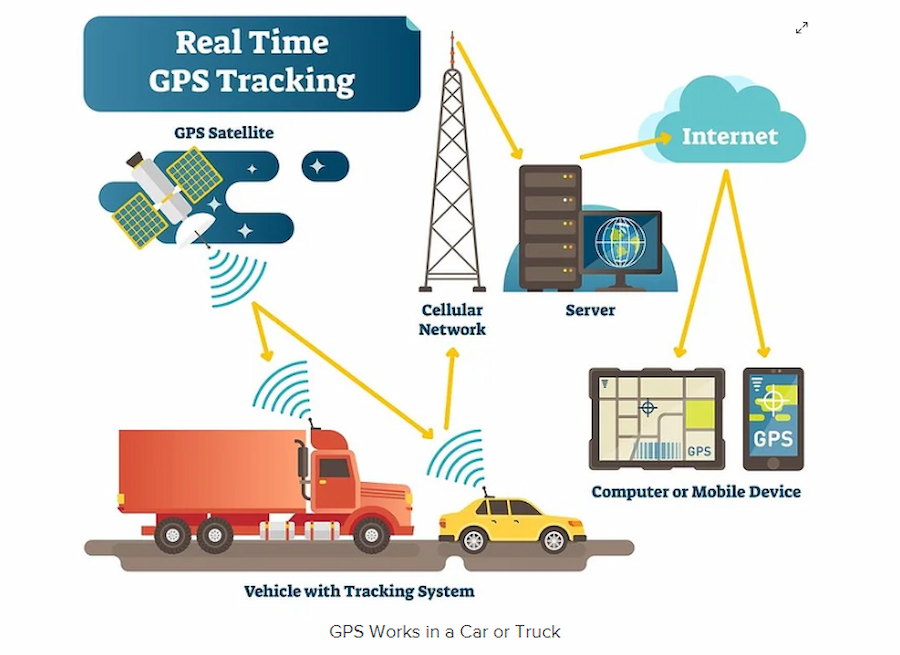
Source: Armellini Logistics
How can I benefit from location-based apps as a business owner?
You can leverage location-based apps to enhance marketing strategies and streamline product or service delivery. Together with digital transformation and e-commerce app development, these apps empower businesses to scale effectively through:
- Better service through quick location tagging. Location-based applications can precisely pinpoint a user’s location to deliver accurate, prompt, and high-value service. For instance, navigation apps can aid in locating the nearest store, dating apps can connect users with nearby prospects, and weather apps can provide accurate rain forecasts.
- Relevant and location-triggered marketing messages. Each place has its predominant activity. Whatever people are doing, you can promote your products and services wherever they are. For instance, you can use an app’s geolocation features and push notifications to promote merchandise discounts once users walk near your store.
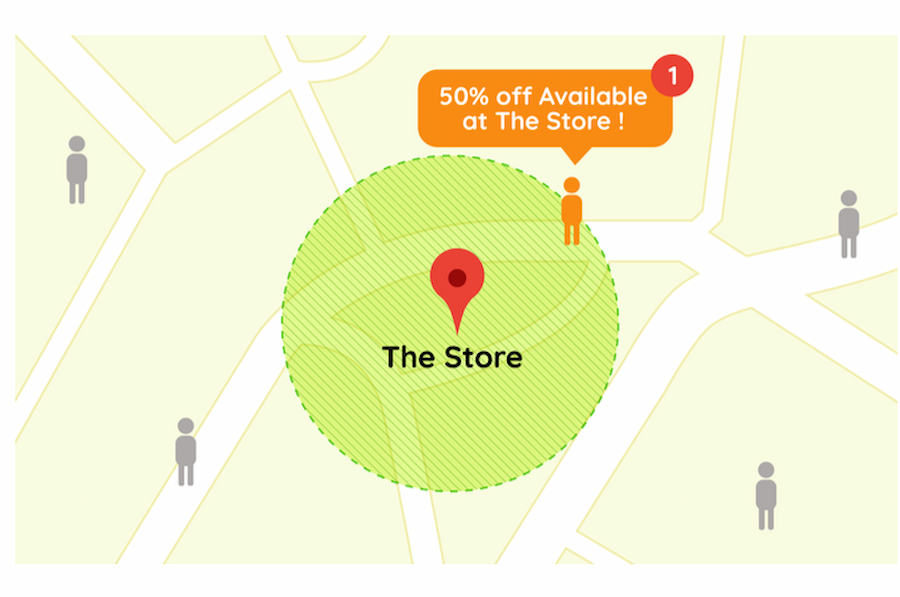
Source: Neil Patel
- Navigation assistance. Location data provided by geolocation apps can help people find their way through streets and highways. In fact, cutting-edge mobile apps like Waze go beyond basic navigation by broadcasting real-time traffic updates.
The 6 Simple Steps to Quickly Build a Cost-Effective Location-Based App
In the competitive industry of geolocation app development, cost management and speed-to-market are key.
To gain an advantage over your competitors, it’s vital to generate an app idea quickly, ensure this vision matches actual market needs, rapidly develop your idea into a location-based app, and publish it without sacrificing quality or wasting financial resources.
Our experience helping numerous organizations grow through app design and development has taught us that the following steps will increase the chances that your location-based mobile app will quickly gain market traction and find its way to long-term success:
Step 1: Use your local area to generate an app idea
When conceptualizing an idea for a new location-based app, there are three major pitfalls you should avoid:
- Relying solely on your own idea of app success
- Going for a global market at the outset
- Spending too much time thinking of the perfect app idea
To avoid this triad of errors, there is one simple solution: ask your local community about their experiences with location apps.
Specifically, ask the people in your neighborhood, school, university, local sports league, church or other groups and organizations near your home. You can also seek related insights from your work colleagues, family, and friends on location-based apps.
After all, these people and groups have likely used apps like food delivery platforms or navigation applications. Whether during a banter or a formal meeting, some insightful questions you can ask your potential market may include:
- Are your food-delivery apps or similar platforms having trouble tagging your exact location? What inconvenience do you suffer when this happens?
- How can an app with geolocation features help you or your organization?
You may add other similar questions to the list above. The answers of the people or groups you speak to would form the basis of your app idea.
And don’t worry whether or not your app idea is perfect. The subsequent steps in the process laid out in this article will help refine your vision further until it becomes a relevant and successful location-based app.
Which brings us to Step 2 of your location-based app development journey: checking out and studying rival applications.
Step 2: Gain insights from competitor apps
How did Japan turn from an insignificant agricultural country to an industrial power? It knew how to mine wisdom even from enemies.
In the 1860s, Japan started hiring large numbers of consultants from foreign companies to modernize its economy. Many of these companies were from Britain and France, Japan’s geopolitical rivals then.
Imagine applying this awe-inspiring success story to your app development journey. Here’s how you could do so.
Instead of being intimidated by competitor apps, take a good look at them. Note their features. See how those features address or fail to alleviate the pain points of the local market you surveyed in Step 1.
There are many competitors in this space, but that’s a good thing since you have a larger pool of ideas from which to draw inspiration. On that note, here are some geolocation apps that have been trending recently.
Social media apps
Imagine logging into your Instagram account and receiving a prompt asking permission to access your location. This action is precisely what makes it a location-based app.
Though people can choose to deny access to their locations, social media apps can enable you to promote and create products, services, or content that aligns with your users’ or target market’s preferences.
Sometimes, all you need to develop your own social media app is a collaborative and industry-leading app agency that has developed highly original platforms like EvrSo. If you want to explore alternative avenues for generating income while connecting people in unique ways, book a free consultation with us.

Dating apps
Finding love in all the right places rests partly on the geolocation technology of dating apps.
Location-based technology is especially useful for seekers who want to maximize cultural compatibility by looking for prospects living in certain areas. To fulfill this need, dating apps leverage location-based tech to pinpoint the city or region where users are located. Typically, dating apps prompt users to disclose their geolocation and then indicate where their potential matches are located.
Some notable examples of dating apps with these capabilities include Tinder and Bumble.
Given the dominance of Tinder and Bumble, you might think no one would dare develop a new dating platform that could go against such apps. But the founders behind an app called Concha have discovered pain points that ache the hearts of many lovebirds: the pain of ghosting and awkward messaging. Check out the Concha case study to learn how this Perth-born app has revolutionized the digital dating scene.
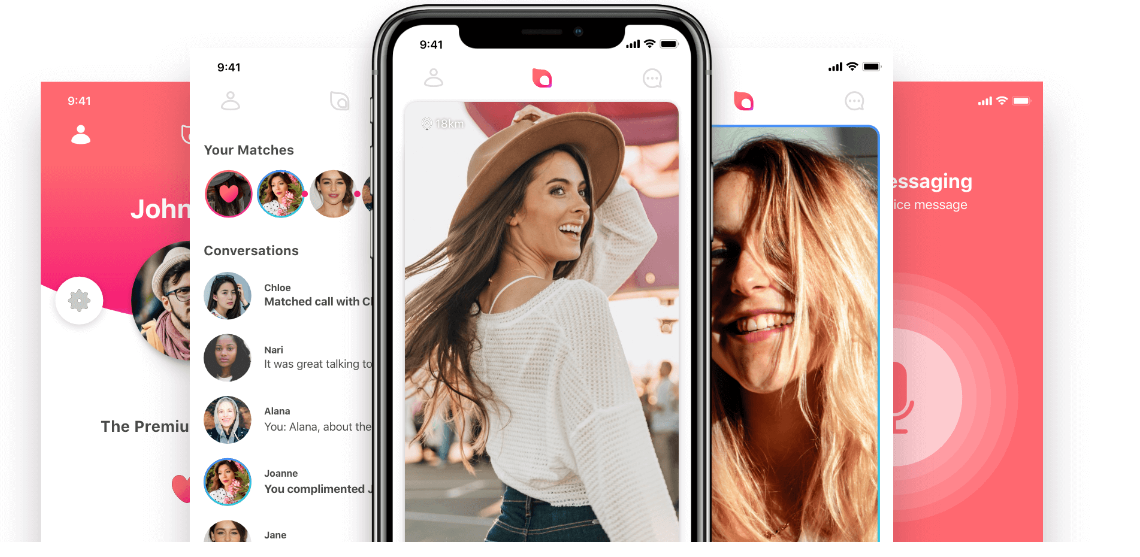
Marketplace apps
Many businesses and entrepreneurs have developed marketplace apps, which are digital platforms connecting multiple sellers to many buyers.
Many users of these platforms seek information on estimated delivery times and the locations of their ordered items. To produce this data, apps like MyDeal and eBay utilize API interfaces, tracking both an item’s and its buyer’s geolocation.
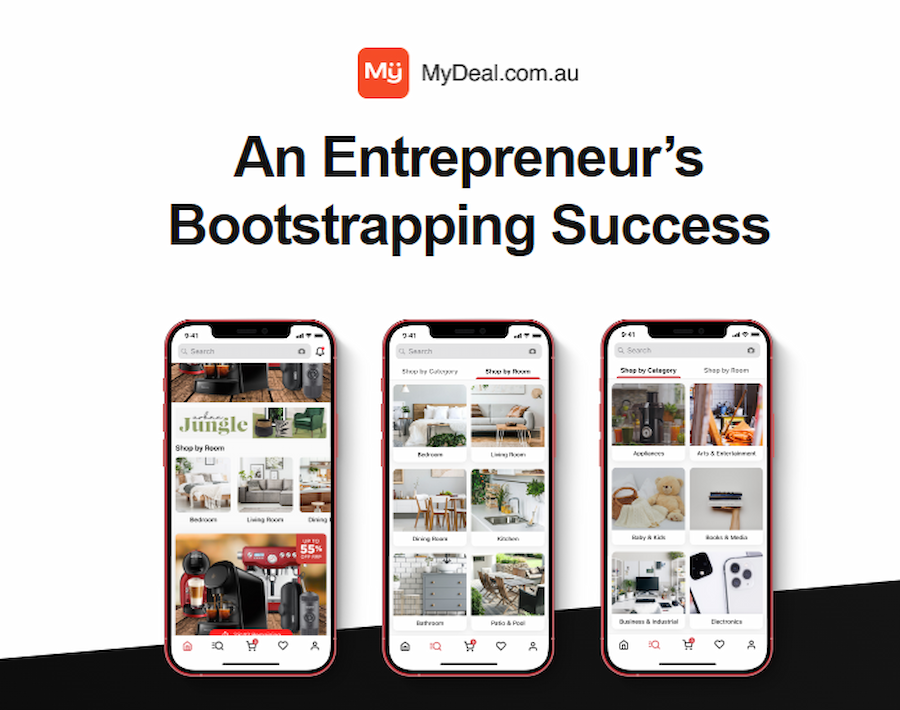
Moreover, marketplace apps can tailor search results to users’ preferences based on location. For instance, users in Ukraine might receive different sneaker suggestions compared to those in the U.S.
Fitness apps
Fitness applications can significantly benefit from incorporating geolocation features, especially for aiding users in their outdoor workouts. Numerous location-based health and fitness apps seamlessly integrate with fitness trackers, enabling users to track and analyze their routes directly through mobile platforms. These apps use global positioning satellites to map the data generated by these users.
Notable examples of fitness apps with location-based features include Nike Run Club and Map My Run.
The insights you gathered from these competitors and your target local market will prepare you for the next step, outlining your app’s basic features.
Step 3: List your proposed features for your MVP app
The minimum viable product (MVP) concept is one of the many tools you can benefit from when aiming to effectively validate your app idea and launch quickly at a manageable cost.
The insights you gathered from your market research and competitor analysis are useful for determining what features to include in your MVP location-based app. An MVP is a fully functional product with only the most basic features. It’s meant to test whether or not a critical mass of your target market will find value in your app.
As time goes by, your MVP app undergoes changes and continuous feedback from potential users. It then evolves into a product that has as many features as your potential market wants.
Ensuring your app matches your market’s preferences is especially vital, given that the absence of market demand is a leading reason why startups fail.
Though Step 3 is MVP-focused, it’s important to note that you won’t actually build your MVP app yet in this phase. What you have to do is just list the features you want to include in your geolocation app based on your findings from market and competitor research. It is in Step 5 that you will actually build your MVP app and spend time polishing it as a product that your potential users will love.
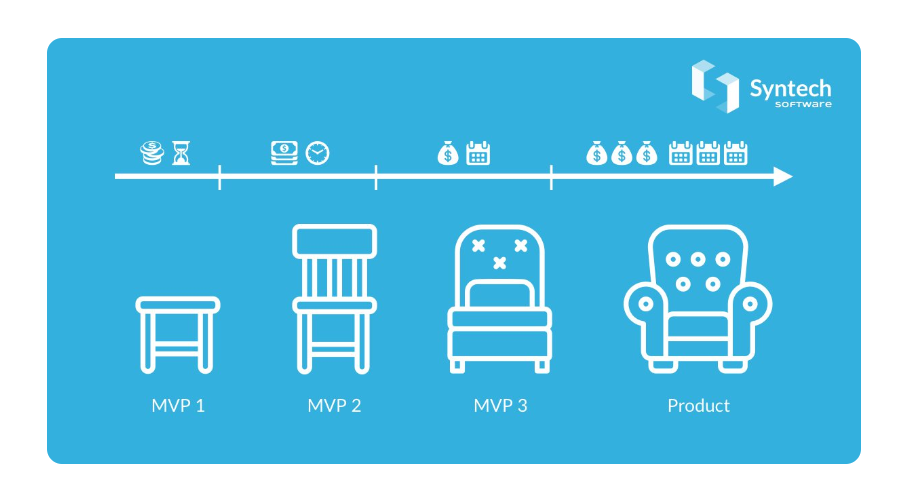
Source: Syntech Software
If you need help outlining your set of MVP features, drop us a line and share your findings about your market and competitors. Let’s discover together the best course of action to turn your vision into a location-based app.
Once you’ve identified what you think should be the basic features of your MVP app, it’s time to proceed to the next phase: app design.
Step 4: Design your app
Contrary to what some may think, location-based apps and other software are not always programmed from the start. When helping our clients develop app ideas, we design apps before programming them.
We also highly recommend the design phase when you seek to create a location-based app on your own.
As you will learn later in this section, app designs help manage app development costs without sacrificing launch speed and quality.
They also hold great potential for acquiring investments. For instance, designs enabled social media startup Vello and tour-tech company Roamni to acquire investments worth around $600,000 and $3 million, respectively. These digital businesses used the financing to turn their designs into fully functional and successful applications.


When our design team helped Vello and Roamni turn their ideas into designs, they spent their time and expertise on two major tasks: wireframing and sketching.
Sketching
In the initial phase of app design, our team utilizes digital tools to create preliminary design concepts that capture the essence of our clients’ app visions and basic features. This stage, known as sketching, allows for exploring diverse design ideas, layouts, and user flows before any programming occurs.
From our extensive experience, we’ve found that project requirements often evolve once development kicks off. Addressing necessary changes during the sketching phase can streamline the development process and minimize expenses. Indeed, it’s far more efficient and cost-effective to refine sketches than to reprogram an app.
Moreover, sketches facilitate effective communication between designers and developers, ensuring alignment on the app’s design and functionality. This clarity guarantees that our clients receive an app that closely aligns with their vision and objectives.
Wireframing
Following the sketching phase, we move on to wireframing, which involves visually mapping out user pathways and considering additional screens and sections for the app.
The primary goal of wireframing is to create an interactive prototype for evaluating functionality, user experience, and overall structure. A prototype looks and feels like a real app but does not have the actual functionalities programmed. The prototyping process helps identify potential usability issues and allows for adjustments before embarking on full-scale development.
Once you’ve refined your app’s design, you can build your location-based app.
Step 5: Develop and test your location-based app
By this point, the features you outlined in Step 3 for your MVP app have undergone many changes. After all, the creation of app designs would have weeded out any unwanted, unnecessary, or unwieldy functionalities. The design phase might have also added new features not conceptualized in Steps 1 to 3.
Whatever the case, your final list of MVP features will be fully implemented in this stage, where you get to create a location-based app.
Though you can build a location-based app on your own, outsourcing development work to app agencies is the most cost-effective way to turn your app idea into a lucrative digital asset. The best of these companies combine friendly but professional collaboration with industry-leading tools and techniques to ensure that the app you launch is of the highest quality and launched as quickly as possible.
Our partners have been able to launch their high-quality apps quickly, partly by taking advantage of our collaboration- and excellence-powered Kanban methodology.
At its core, Kanban revolves around the following principles:
- Visualizing work
- Limiting work in progress
- Continuous improvement

Source: Simon Sez IT
We prefer this software development method so our clients can have substantial control over the project and their budget. Kanban’s visual outlining of workflows also helps our development team stay on track and on schedule, leading to the best possible output.
Specifically, here’s how our team implements the Kanban method when developing apps and testing them for quality:
- Initially, our team allocates our clients’ MVP feature requirements into Kanban months, establishing a roadmap for product development.
- Subsequently, our team collaborates with our clients on app development, with the team size adjusted according to the complexity of project features and requirements.
- Aligned with the priorities outlined in the roadmap, the development team implements the necessary basic features according to the Kanban month schedule. The team also conducts mobile app testing to ensure the output is as reliable and high-performing as possible.
- Our product manager and development team communicate regularly with clients to gather feedback on the apps we develop, incorporate any suggestions, and enhance the applications accordingly.
By partnering with us in your location-based app development project, our Kanban method provides you with complete control over the pace of development each month. You can effortlessly scale up, downsize, or pause at any juncture without limitations. In short, you won’t get stuck in expensive and suboptimal lock-in contracts.
If any features exceed the allocated time, they are rescheduled for the following month, with adjustments made to the roadmap as needed. Upon completing the Kanban months within the MVP scope, your app will be primed for launch.
In an ideal scenario, the Kanban method results in location-based apps that closely align with user expectations and possess the speed-to-market advantage. Upon completion of development and testing, you’ll be prepared to launch your app into the market.
Step 6: Launch, market, and expand
Initiate pre-launch marketing efforts while your location-based app is in development and prior to its debut on app stores. Set up a compelling landing page or website to attract potential users and encourage them to sign up for your app. Additionally, consider organizing events at various venues, such as hotels and supermarkets, to generate interest in your application.
Planning and executing pre-launch marketing strategies can help build excitement, stimulate interest, and create anticipation for your app before its official release. This approach broadens your reach and can potentially lead to increased downloads and sign-ups upon launch.
Upon publishing your location-based app on app stores, focus on optimizing your app store page to enhance the visibility of your application. Implement robust SEO tactics, leverage social media platforms for promotion, and apply other effective app marketing techniques.
After the launch, use mobile analytics tools to track crucial app metrics such as acquired active users and average session duration to pinpoint areas for enhancement.
Continuously roll out timely updates to address any bugs and improve user experience, ensuring consistent engagement and growth. This proactive approach is vital for maintaining momentum and sustaining interest in your app.
If your app’s enhancements attract a significant influx of new and loyal users, you can explore global expansion if the app is ready for it. That’s what sports prediction startup PointsBet did. After it gained traction in Australia, it leveraged digital marketing and other tools to successfully expand to the U.S. market. Check out the PoinstBet case study to discover how the startup became a billion-dollar company soon after American expansion.


Put yourself on the map with a location-based app
Cutting-edge location-based digital platforms have made mapping more accurate, user-friendly, and helpful for various needs and situations. The market for these “apps with maps” is certainly growing—and there’s still room for the next big idea.
Where do you stand in an increasingly digital economy?
Life offers many compasses that guide us in the right direction. For location-based app development, we might be the ideal companion you need for your technological journey. Give us a call to start putting your vision or business on the digital map.

Jesus Carmelo Arguelles, aka Mel, is a Content Marketing Specialist by profession. Though he holds a bachelor’s degree in business administration, he also took courses in fields like computer troubleshooting and data analytics. He also has a wealth of experience in content writing, marketing, education, and customer support.


